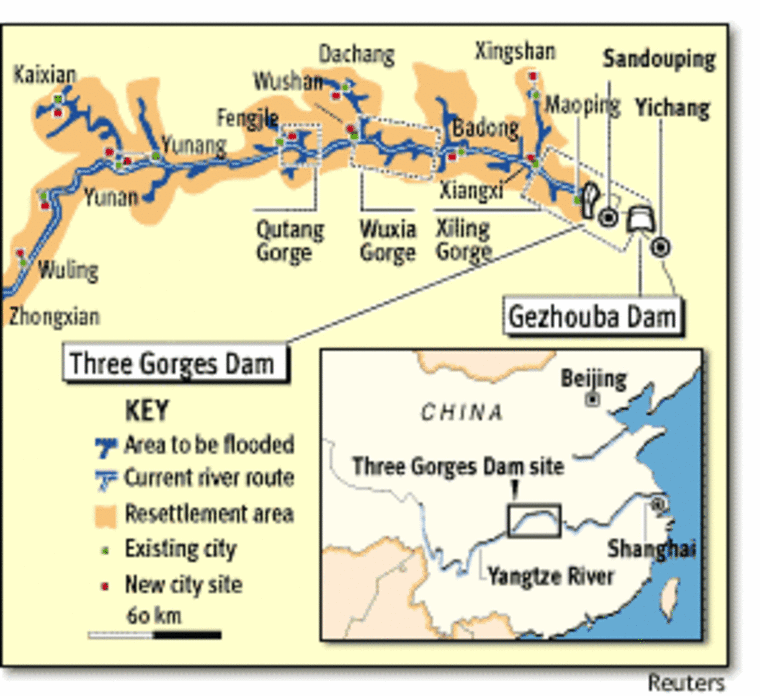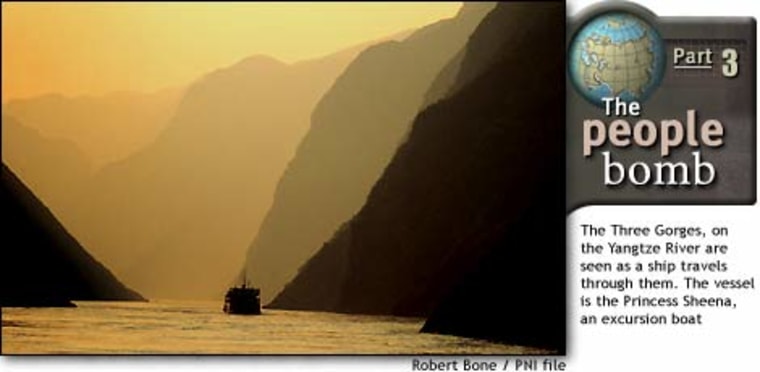Before the building of the massive Three Gorges Dam began, Chinese and foreign tourists rushed to see the Yangtze River before it changed forever. Passengers packed onto ferries carrying 600 to 700 people. At key moments, they would rush out onto all decks - to view ancient temples, rocks shaped like a mythical figures, and finally, the Three Gorges - where the river passes between soaring cliffs.
But China's longest river is more than just a wilderness experience. It’s also been an economic lifeline for millions.
The Yangtze, which runs 2,400 miles from Tibet to the Pacific Ocean has long been one of the most heavily populated places in China. Experts say its watershed supports 400-500 million people. They live in massive industrial cities like Chongqing, and Wuhan, They farm the lower reaches, right up to the edges of this volatile river, and along its many tributaries and flood plains. In the upper reaches, where people are especially poor, many make their money through lumbering, or cutting firewood for heating.
Now, as the government embarks on construction of one of the biggest hydroelectric dams on earth, there is a building boom near the site, just downstream from the Three Gorges Dam, as developers attempt to cash in on the multi-billion dollar project. Laborers have arrived from around the country to help.
“The Yangtze brings to a head many of the many major issues in China,” says Josh Muldavin, chair of international development studies at University of California Los Angeles.
Historical flooding
The most dramatic illustration of the Yangtze’s dilemma was the flooding that occurred in the summer of 1998, the largest for 50 years. After the devastation, which claimed 3,656 lives and cost the nation $38 billion, Beijing took a tough line against old-growth lumbering in the upper reaches of the river, places like Sichuan and Yunnan province.
But as with most directives in China, provinces, counties and villages implement only what they feel they can afford. Some took the central government money and paid workers to plant trees instead of cut them, as instructed, according to Greenpeace China executive director Ho Wai Chi.
But some didn’t think it was enough to make up for lost profits from lumber sales. “There was various implementation,” says Ho. “Some people cut trees as fuel and coal is too expensive for them. So you can’t just blame them for cutting trees. Also provinces still wanted to generate money… so they just disregarded it.”
Monumental plan
Beijing shouldn’t have been surprised by the intensity of the disaster, in part because flooding along the river has been increasing since the early Communist days, when China’s modernization drive began, and clear cutting was common. One of the most common criticisms of the Mao era was its infamous destruction of natural resources.
Ever since that period, leaders have dreamed of building the Three Gorges Dam, in part to control flooding. It was discussed, according to popular history, even by Sun Yatsen, a pre-revolutionary nationalist hero, and debated throughout the last five decades of Communist rule.

Again and again the plan was laid aside because of the engineering obstacles - this will be, by some measures, the biggest hydroelectric dam in the world-or because of cost, close to $30 billion. In the last decade, the debate has centered around the dam’s environmental impact, at a time when large dams like it have been discredited around the globe.
One of the biggest practical considerations is that the dam requires removal of more than 1 million people, mostly farmers and villagers. Expense is one problem. Just where to put a million farmers after removing them from the rich land around the river, is another.
Finally, not all observers even agree that the dam will work in preventing floods. Perhaps it will prevent future disasters downstream. But some experts believe that upstream silting will eventually force water over the banks, causing new flooding in the upper reaches.
“China would make better use of the billions of dollars being spent on the dam by investing it in maintaining the 30,000 kilometers of dykes along the Yangtze River and its tributaries,” according to a statement by the International Rivers Network. “Money should also be spent on the upkeep of overflow lakes along the middle and lower Yangtze.”
Fouling the water
Quite aside from the noisy debate over the dam, is the quiet rise of contamination from industry and chemical fertilizer run-off along the Yangtze. Already up-river mega-city Chongqing has miles of factories spewing smoke into the air, making it famous for its acid rain problem.
Nearing the mouth at Shanghai is the most heavily industrialized area in the country, and one of the worst sources of water pollution.
Now, the dam will make the river navigable for larger ships to move much farther up the river, encouraging plants to move their operations further upstream.
There have been some efforts to limit the contamination flowing into China’s coasts and rivers. The World Bank has major water purification projects, and the Chinese government has labeled one of the Yangtze’s main tributaries, the Wai River, a priority clean-up site. It also made efforts to close down some of the most polluting plants along the Yangtze - those producing paper and pulp - with limited success.
These efforts are at best disjointed, and as often as not disobeyed. One major problem is money that is diverted away from projects through graft or waste - a problem that is unlikely to disappear as long as China is poor and its civil servants un-elected and poorly paid.
In a country that is bursting to be prosperous immediately, many of the real solutions are infuriatingly long term - replanting, providing job alternatives to lumbering and dirty industries, replacing old facilities with clean technology and adding water treatment plants.
Not least of these is the challenge of education. As the tourist boats ply the river, packed to the gills with passengers admiring the view, many blithely toss their cigarettes, styrofoam dinner boxes and other wrappers overboard. The boat disgorges all the collective sewage from the three-day trip into the Yangtze before dropping its passengers in the city of Wuhan.
